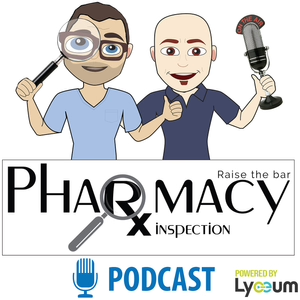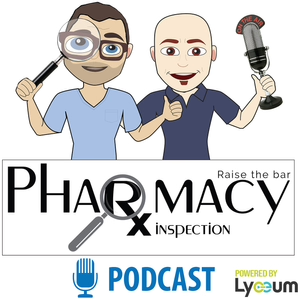
SterileAF Podcast
Seth DePasquale, R.Ph., BCSCP
All episodes
Best episodes
Top 10 SterileAF Podcast Episodes
Goodpods has curated a list of the 10 best SterileAF Podcast episodes, ranked by the number of listens and likes each episode have garnered from our listeners. If you are listening to SterileAF Podcast for the first time, there's no better place to start than with one of these standout episodes. If you are a fan of the show, vote for your favorite SterileAF Podcast episode by adding your comments to the episode page.

Pharmacy Inspection Podcast Episode 9 - Joe Cabaliero and Bill Mixon
SterileAF Podcast
01/09/18 • 26 min

03/17/20 • 8 min
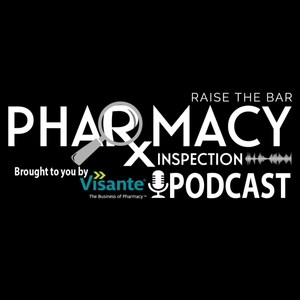
USP 795 Revisions
SterileAF Podcast
10/08/21 • 18 min
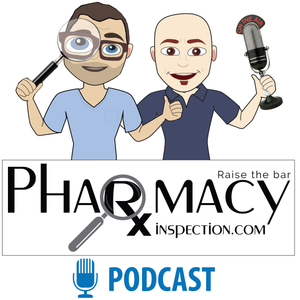
Pharmacy Inspection Podcast - Episode 40 - Cleanroom design mistakes you shouldn't make
SterileAF Podcast
05/20/20 • 9 min
Bryan lays out two mistakes that he recently came across in a very well designed 3D model of a cleanroom...the only problem, there were two fairly critical mistakes. Don't make these mistakes...
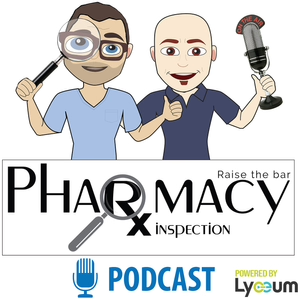
FDA 483 #8 - Using ungraded ingredients
SterileAF Podcast
10/09/20 • 12 min
Learning Objectives
- Discuss the use of USP graded ingredients in pharmaceutical preparations and the importance
- Explain what prompted the FD&C act of 1938 to be enacted
In this weeks 483 Friday we're going to be talking about the use of ungraded ingredients in pharmaceutical preparations. First, I'd like to show you a 483 where this was done, then we'll look at a case where non-USP ingredients led to real issues in patients where the drug product contained non-USP graded ingredients.
Let's take a look at the first 483:
In this 483 it looks like the use of grain alcohol was used to make several products. Of course, using everclear 95% is NOT a USP graded alcohol and is actually meant to be for consumption, but not as a pharmaceutical ingredient.
So what's the difference of whether something is USP-graded and a substance that doesn't carry that same grade? First, USP graded ingredients are tested for a number of things including the stability of the ingredient itself. This is the major difference between those ingredients that carry the USP grading and those that do not.
First, is there such a product that exists for this pharmacy? Are there USP graded ethanols that could've been used in this product? The answer is yes. There is in fact a USP monograph for ethanol which typically means that alcohol USP can be found in the market that's been tested for impurities and degradation products. So the easiest way to solve the issue for this pharmacy is to simply use USP graded 200 proof alcohol.
I would like to note that in this particular 483 it's noted that this pharmacy is a "Producer of Non-Sterile Drug Products". So one thing I can say is that all of their products were being used for topical use and not to be consumed. Nonetheless, the alcohol used was not USP-graded so the point that the final preparation wasn't consumed orally or by given by injection still doesn't necessarily matter.
The next question in my mind, if there is no substitute for something that is intended to be laboratory grade, is there a way to qualify this ingredient for use in your drug product. I would say yes, however much research and testing would need to be done prior to its use. How to go about doing that goes beyond what this episode will cover but the possibility is there.
Next, let's look at a scenario where using non-USP graded ingredients were used in an injection and actually caused harm to the patient.
In 2017, there were two infusions of curcumin compounded with non-USP graded polyethylene glycol (PEG) 40 castor oil. As a result when these injections were administered patients had hypersensitivity reactions to the IV product. Note that in this preparation it actually was administered intravenously, so this was a sterile product.
So what happened to these patients and why? The FDA reports:
On March 10, 2017, the U.S. Food and Drug Administration received an adverse event report concerning a 30-year-old female patient who experienced cardiac arrest after IV administration of a curcumin emulsion product...The patient reportedly had a history of allergies and was being treated for eczema by a naturopathic doctor. Within minutes of starting the infusion, the patient became pulseless and required CPR. The patient suffered anoxic (depleted oxygen) brain injury and subsequently died. An adverse reaction to infused curcumin solution was identified as a cause of death by the local authorities.
In a second case where this drug was administered the FDA reports:
On May 1, 2017, FDA received an adverse event report concerning a 71-year-old male patient who developed a hypersensitivity reaction after IV administration of (name of facility removed) compounded curcumin emulsion product. The patient had a history of allergies and was being treated for thrombocytopenia (a low platelet count) at a holistic health center. According to information FDA received from the center, within minutes of starting the infusion, the patient developed a cough and erythema (skin reddening). Diphenhydramine (an antihistamine) was administered; however, symptoms escalated to include shortness of breath, itching, and hypotension (low blood pressure). The patient was treated with IV epinephrine and transferred to a nearby emergency room where he was treated and then released.

Greg Stanley - IV Workflow
SterileAF Podcast
04/15/22 • 32 min
Thanks for tuning in to the Pharmacy Inspection Podcast! Today we have Pharmacist Greg Stanley on the show and we're going to be talking about implementation of an IV workflow system!
Greg Stanley received his Bachelor of Science in Pharmacy degree in 1998, having also completed undergraduate research fellowships in Biological/Environmental Sciences and Polymer Sciences. He has over twenty-five years of experience with compounded sterile products; both in hospital and home infusion settings. Greg has extensive experience with policy development, staff training, pharmacy management and regulatory compliance.
Currently, Greg is an Associate Director at SUNY Upstate Medical University. He is involved with several projects related to USP and USP . His oversight includes sterile compounding, hazardous compounding, and robotic/automated technologies.
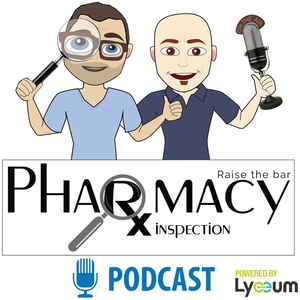
483 Friday #7 - Viable Air Sampling
SterileAF Podcast
10/02/20 • 13 min
- Explain the purpose of viable air sampling
- Discuss how conclusions can be made from the results of viable air sampling
Happy Friday!
This weeks 483 we're going to focus on viable air sampling, which is one part of an environmental sampling plan. The information gained from viable air sampling can be very telling of the cleanliness and control you have over your cleanroom.
In this particular 483 viable air sampling was performed by a third party testing company for the purposes of re-certifying the cleanroom. Here's what the observation said:
So if you're unfamiliar with viable air sampling, it's the type of sampling where you use a piece of equipment to draw in a known volume of air and impact the air on a plate of growth media to see if there are microorganisms in the air.
This 483 states that a third party contractor had done the viable air sampling inside their ISO 5 engineering control or hood and in their ISO 7 buffer room. What's interesting here is that the 483 shows the results from not one certification of their cleanroom but the inspector reported a second certification six months later as well. What's most concerning is the April 2019 results where a total of 19 CFU or colony forming units were found. However, six months later, while there was still microorganisms found in the air in the same location, it was much less with only one found. Let's continue to just focus on the ISO 5 location as this is the most critical part of the cleanroom as this is where the compounding is performed.
In either case, April and October, an investigation should have been done in the cleanroom to figure out what the underlying issue is. I encourage you to go back and listen to the podcast episode on Investigations and CAPAs for learning how to properly investigate and document microbial excursions.
In this 483, because it was a third party contractor, they also reported the type of organisms present. This can be extremely helpful in finding out the root cause of the contamination. In April, 19 CFU were found and they were:
- Bacillus
- Coagulase negative Staphylococcus
- Micrococcus
There's actually a chart within USP that tells us when we should take action if there's greater than 1 CFU found to be in our ISO class 5 area. So the fact that in April there were 19 found, an investigation absolutely should have been performed.
Looking up where these particular microorganisms come from would be the first step in an investigation. Bacillus are gram positive bacteria that are usually able to form spores, which are highly resistant when they're in their spore form. Bacillus can be found in soil or can be of animal origin.
Coagulase negative staphylococcus and micrococcus are typically normal flora found on humans. This information gives us two possible places to look for ingress routes for these organisms: materials and people or operators inside the cleanroom.
Remember, these were found in their ISO class 5 engineering control which is supposed to be extremely clean and free of microorganisms at any given time. So this could also suggest that maybe there's something wrong with their engineering control as well as it should be actively pushing microorganisms out of the hood.
In an investigation, we would possibly look at:
- Gowning procedures for operators
- Cleaning procedures: what agents are being used, the frequency of cleaning
- Operator technique while inside the cleanroom
- Our process for bringing materials into the cleanroom
- The engineering control itself: is it working properly, is there enough airflow, is there anything wrong with the HEPA filters
Six months later when the recertification was done again, there was only 1 CFU of bacillus found in the ISO 5 hood. This suggests that the firm did possibly investigate the cause of the contamination and made some improvements. However, there was no documentation found to definitively say that was done. I will say it might've been helpful if there was also results from surface sampling in the hood as this might give us further indication of what was causing the contamination.
Without sharing the entire 483, there are other key issues found that suggest other possibilities. For instance observation 2 notes that cleaning is performed in the ISO 5 area with non-sterile cleaning agents and wipes. Observation 6 discusses how there's a loose light fixture inside the ISO 5 laminar airflow hood. Observation 8 points out that prior to entering the cleanroom some materials were not disinfected. In observation 9 it's discovered that there's signs of rust and chipped paint inside the ISO 5 laminar airflow...
Show more best episodes

Show more best episodes
FAQ
How many episodes does SterileAF Podcast have?
SterileAF Podcast currently has 56 episodes available.
What topics does SterileAF Podcast cover?
The podcast is about Health & Fitness, Pharmacy, Medicine, Compliance and Podcasts.
What is the most popular episode on SterileAF Podcast?
The episode title 'Pharmacy Inspection Podcast - Episode 39 - PAYING TOO MUCH FOR VIABLE SAMPLING!?' is the most popular.
What is the average episode length on SterileAF Podcast?
The average episode length on SterileAF Podcast is 22 minutes.
How often are episodes of SterileAF Podcast released?
Episodes of SterileAF Podcast are typically released every 7 days, 23 hours.
When was the first episode of SterileAF Podcast?
The first episode of SterileAF Podcast was released on Oct 17, 2017.
Show more FAQ

Show more FAQ
